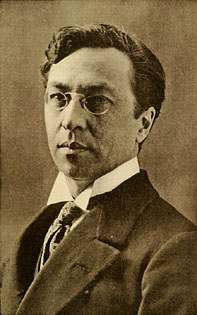Voir l'invisible, Michel Henry, 1988
Vassily Kandinsky citations célèbres
Voir l'invisible, , 1988
Cette base sera définie comme le principe de la nécessité intérieure.
Du spirituel dans l’art, 1911
Voir l'invisible, , 1988
Point et ligne sur plan, 1926
Du spirituel dans l’art, 1911
Citations de l'âme de Vassily Kandinsky
Du spirituel dans l’art, 1911
Du spirituel dans l’art, 1911
Regards sur le passé, 1912-1922
Vassily Kandinsky: Citations en anglais
“If the artist has outer and inner eyes for nature, nature rewards him by giving him inspiration.”
Source: 1916 -1920, Autobiography', 1918, p. 14
1910 - 1915, On the Problem of Form (1912)
Source: 1916 -1920, Autobiography', 1918, p. 31
V. The psychological working of Colour: Quoted in: Hajo Düchting (2000) Wassily Kandinsky, 1866-1944: A Revolution in Painting. p. 17
Alternative translation:
Colour is a means of exerting direct influence on the soul. Colour is the keyboard, the eyes are the hammers, the soul is the piano with many strings. The artist is the hands which plays touching one key or another purposively to cause vibrations in the Soul; in: Anna Moszynska, Abstract Art, Thames and Hudson, 1990
Source: 1910 - 1915, Concerning the Spiritual in Art, 1911
“That is beautiful which is produced by the inner need, which springs from the soul.”
Source: Concerning the Spiritual in Art
2 quotes from Kandinsky's letter to Hans Arp, November 1912; in Friedel, Wassily Kandinsky, p. 489; as cited in Negative Rhythm: Intersections Between Arp, Kandinsky, Münter, and Taeuber, Bibiana K. Obler (including transl. - Yale University Press, 2014
Kandinsky was trying to explain to Arp his state of mind when he made his sketch for 'Improvisation with Horses' https://upload.wikimedia.org/wikipedia/commons/c/ce/Wassily_Kandinsky_Cossacks_or_Cosaques_1910%E2%80%931.jpg, 1911, a watercolor belonging to Arp. Kandinsky had told Arp that he could have one of his pictures included in the 'Moderne Bund' (second) exhibition in Zurich, 1912, and this was the one Arp selected
1910 - 1915
Quote from his letter to Alfred Barr, Jr., 16 July, 1944; as cited in Vivian Endicott Barnett, et al., 'Kandinsky', exh. cat. [New York: Solomon R. Guggenheim Museum, 2009], p. 70
1930 - 1944
“Alors sempre avanti! (Ever Forward / Always Ahead)”
Quote from his letter from Paris to Paul Klee in Switzerland, 12 December 1939; as cited in 'Klee & Kandinsky', 2015 exhibition text, Lenbachhaus und Kunstbau Munich, 2015-2016 https://www.zpk.org/en/exhibitions/review_0/2015/klee-kandinsky-969.html
1930 - 1944
as quoted by de:Wolf-Dieter Dube, in Expressionism; Praeger Publishers, New York, 1973, p. 102
1920 - 1930
III. The Movement of the Triangle
1910 - 1915, Concerning the Spiritual in Art, 1911
Quote in Kandinsky's letter to Gabriele Münter, 1915; as cited in Schönberg and Kandinsky: An Historic Encounter, by Klaus Kropfinger; edited by Konrad Boehmer; published by Routledge (imprint of Taylor & Francis, an informal company), 2003, p. 16 note 54
1910 - 1915
1910 - 1915
Source: On the Spiritual in Art, 1911; as quoted in Schönberg and Kandinsky: An Historic Encounter, by Klaus Kropfinger; edited by Konrad Boehmer; published by Routledge (imprint of Taylor & Francis, an informal company), 2003, p. 15
Kandinsky's last theoretical statement (Paris, 1942); in Kandinsky, Frank Whitford, Paul Hamlyn Ltd, London 1967, p. 38
1930 - 1944
Quote from his letter to Freundlich, 15 July 15, 1938; as cited in Kandinsky in Paris: 1934-1944 - exhibition catalog, published by The Solomon K. Guggenheim Foundation, New York, 1985, p. 27
1930 - 1944
Quote from Kandinsky's letter to Will Grohmann, c. 1926; as cited in Kandinsky, Frank Whitford, Paul Hamlyn Ltd, London 1967, p. 36
1920 - 1930
There is no 'must' in art, which is forever free.
Quote from: Kandinsky: Complete Writings on Art, eds. Kenneth C. Lindsay and Peter Vergo, 2 Vols. (transl. Peter Vergo); Boston: G.K. Hall & Co., (1982), p. 195; as cited in: Samet, Jennifer Sachs. Painterly Representation in New York, 1945-1975. Dissertation, The City University of New York, 2010. p. 25
1910 - 1915
to Werner Drewes, 10 April 1933; as quoted in 'Klee & Kandinsky', 2015 exhibition text, Lenbachhaus und Kunstbau Munich, 2015-2016 https://www.zpk.org/en/exhibitions/review_0/2015/klee-kandinsky-969.html
both were closely connected with the Bauhaus, closed by the Nazi-regime in 1933
1930 - 1944
1920 - 1930, Point and line to plane, 1926
I. Kandinsky's introduction
1910 - 1915, Concerning the Spiritual in Art, 1911
Quote of Kandinsky, 1913; in the introduction of an exhibition-catalog 'Neue Künstlervereinigung', Munich; as cited by , in Expressionism; Praeger Publishers, New York, 1973, p. 120
1910 - 1915
VIII. Art and Artists
1910 - 1915, Concerning the Spiritual in Art, 1911
footnote, p. 15
1916 -1920, Autobiography', 1918
Quote in Kandinsky's letter to Arnold Schönberg, 18 Jan. 1911; as cited in Schonberg and Kandinsky: An Historic Encounter, by Klaus Kropfinger; edited by Konrad Boehmer; published by Routledge (imprint of Taylor & Francis, an informal company), 2003, p. 9
1910 - 1915
Quoted in: Sunil Goonasekera (1991) George Keyt, Interpretations. p. 146
Talking about the means in painting
1910 - 1915, Concerning the Spiritual in Art, 1911
VI. The language of Form and Colour
1910 - 1915, Concerning the Spiritual in Art, 1911
Wassily Kandinsky to Will Grohmann, 4 Dec. 1933; as quoted in 'Klee & Kandinsky', 2015 exhibition text, Lenbachhaus und Kunstbau Munich, 2015-2016 https://www.zpk.org/en/exhibitions/review_0/2015/klee-kandinsky-969.html
1930 - 1944
